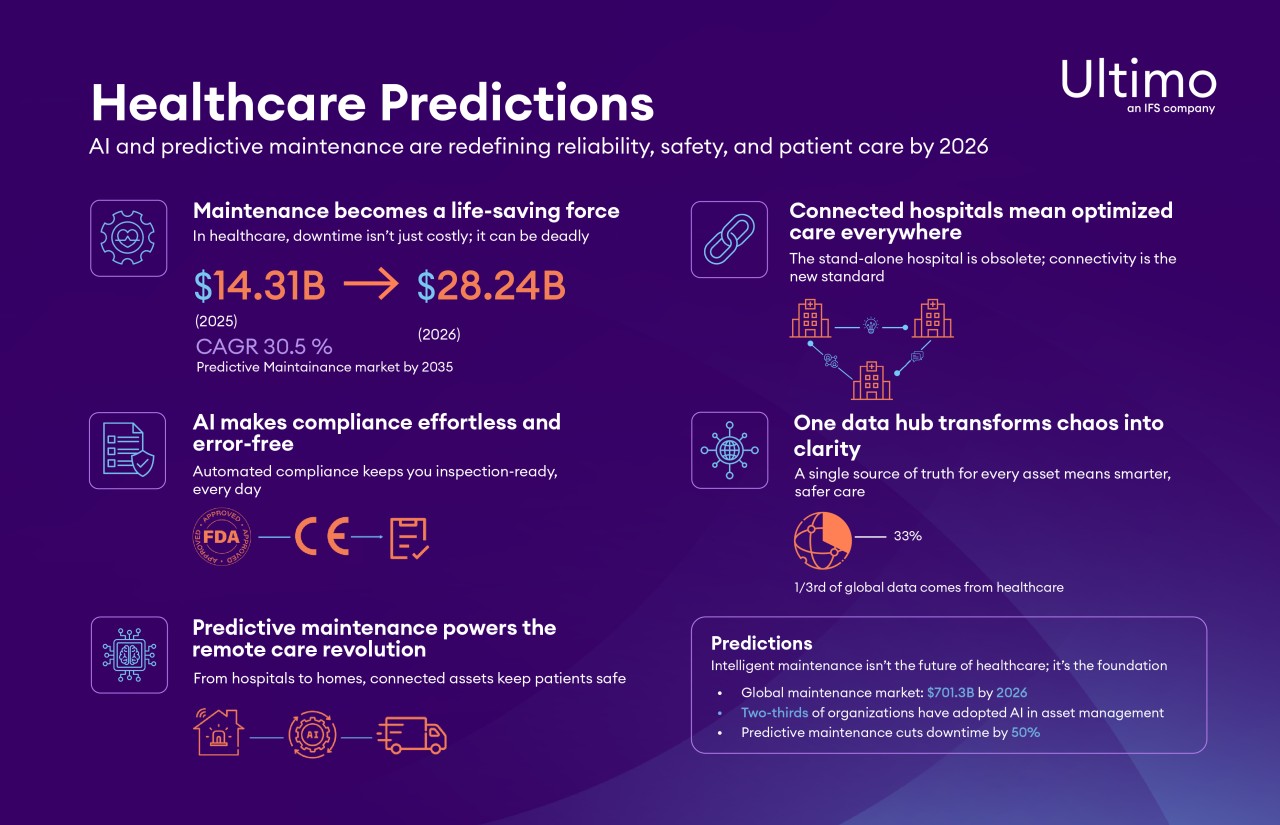The ventilator that fails mid-surgery. The MRI machine down for weeks waiting for parts. The infusion pump that malfunctions during critical care. These aren't hypothetical scenarios. They're daily realities in hospitals struggling with reactive maintenance strategies. As we move through 2026, healthcare organizations can no longer afford to wait for equipment to break. The stakes are too high, and the margins are too thin.
At Ultimo, we see a different future. One where intelligent asset maintenance becomes healthcare's secret weapon against rising costs and a powerful driver of patient safety. Here are our five predictions for how asset maintenance will revolutionize healthcare delivery in 2026.
1: AI-Driven Medical Equipment Optimization Saves Lives
By 2026, leading healthcare organizations will deploy artificial intelligence (AI) systems that predict critical equipment failures before they endanger patients. Imagine a world where your maintenance team receives an alert 72 hours before a surgical laser begins degrading, or where life support systems self-report anomalies before they become emergencies.
This isn't science fiction. Predictive maintenance technologies are already demonstrating remarkable results across industries. Research demonstrates that predictive maintenance cuts unplanned downtime by up to 50 percent compared to reactive approaches, according to McKinsey & Company. In healthcare, where downtime can mean the difference between life and death, these improvements are transformative.
AI systems will use real-time utilization data to schedule maintenance without interrupting clinical operations. Real-time monitoring of imaging equipment, surgical instruments, and life support systems will provide instant failure prediction. Most importantly, machine learning models will help to prioritize maintenance on equipment with the highest impact to patient health.
According to Research Nester, the predictive maintenance market is projected to grow from $14.31 billion in 2025 to $28.24 billion in 2026, with a 30.5 percent compound annual growth rate expected through 2035. Healthcare providers investing now will gain a competitive advantage in both cost management and patient safety.
2: Regulatory Compliance Becomes Automated and Airtight
Healthcare maintenance teams spend countless hours on documentation and regulatory reporting. By 2026, AI-powered compliance monitoring will automate these burdens while ensuring maintenance activities meet strict healthcare quality standards.
Automated documentation and reporting for Food and Drug Administration (FDA), CE (European conformity) marking, and international medical device regulations will become standard. Predictive compliance alerts will prevent equipment from falling out of certification before critical procedures, eliminating the panic of last-minute recertifications.
According to recent studies, two-thirds of organizations already report having implemented AI in their asset management practices. Healthcare organizations that lag behind risk not only regulatory penalties but also compromised patient care.
3: Connected Healthcare Ecosystems Enable Smarter Resource Allocation
The stand-alone hospital is becoming obsolete. Medical equipment data will start to integrated with hospital systems. Cross-facility asset sharing and maintenance coordination for hospital networks will optimize resource utilization across entire health systems.
Real-time equipment availability data will enable dynamic resource allocation during patient surges or emergencies. Standardized maintenance protocols across global healthcare networks will ensure consistent care quality regardless of location.
The global maintenance market is predicted to hit $701.3 billion by 2026, reflecting this transformation. Healthcare organizations that embrace connected ecosystems will capture significant value from this growth.

4: Remote Care Demands Distributed Asset Intelligence
Telemedicine and home healthcare are no longer supplementary services. They're core delivery models. By 2026, predictive maintenance for home healthcare devices and remote monitoring equipment will be essential.
AI-powered diagnostics for medical devices in patients' homes will trigger automated technician dispatch before devices fail. Global supply chain optimization will ensure critical spare parts availability across all care settings. Remote troubleshooting and virtual maintenance support will significantly reduce on-site visits, improving care continuity in underserved areas.
5: Unified Data: The Foundation for Transformation
Recent estimates show that nearly one third of the world's data volume comes from the healthcare industry. For Healthcare Technology Management (HTM) teams, this immense data volume should provide deep insights into critical asset and facility performance. Instead, fragmented technology stacks create information silos.
HTM teams juggle multiple platforms: asset tracking systems, work order software, compliance databases, inventory management tools, and vendor portals. Each system holds pieces of the puzzle, but no single platform reveals the complete picture. When an MRI machine underperforms, technicians waste hours cross-referencing systems to understand whether it's a maintenance issue, a parts problem, a compliance gap, or an operator training need.
A modern Enterprise Asset Management (EAM) system solves this challenge by serving as a single hub that integrates all data sources. Through robust API connections and standardized data protocols, the EAM platform pulls information from disparate systems into one unified interface. Maintenance teams gain complete visibility: asset history, real-time performance metrics, compliance status, parts inventory, vendor information, and predictive analytics all in one place.
This integration transforms reactive chaos into proactive strategy. When all data flows through a central EAM system, AI and machine learning models can identify patterns invisible in isolated systems. This leads to smarter maintenance decisions, reduced costs, and most importantly, safer patient care.
Your Journey Starts Now
The transformation I describe isn't coming. It's here. Healthcare organizations that embrace intelligent asset maintenance in 2026 will thrive. Those that cling to reactive approaches will struggle under the weight of rising costs and increasing risk.
Every healthcare organization is on its own journey toward more mature asset management practices. Your position on that journey matters. That's why we strongly believe every healthcare provider should map its progress using the Ultimo EAM Maturity Model.
Don't wait for a critical equipment failure to force change. Book a demo with Ultimo today and discover where you are on your asset maintenance journey. We'll help you pinpoint your current position, plot your path forward, and benchmark your preparedness for the 2026 healthcare landscape.
Transform from reactive to intelligent. Build a maintenance organization that drives reliability, compliance, and patient safety in the modern healthcare era.
